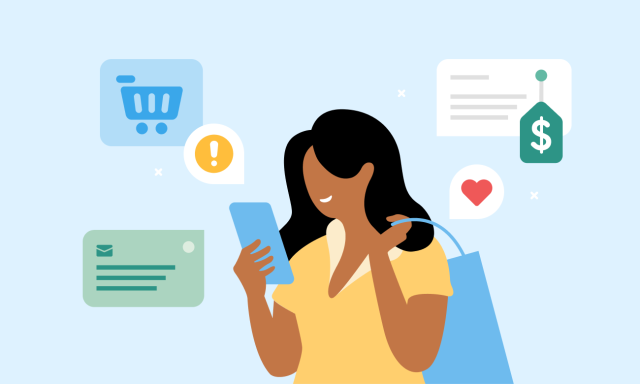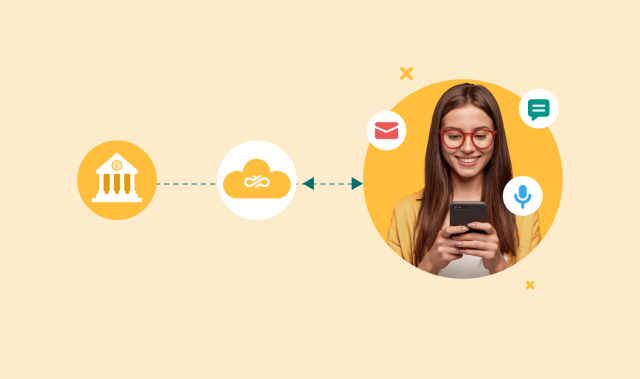In this article:
It’s pretty easy to get lost in all of the jargon about modern mobile phones and platforms. If you’ve been looking for ways to improve open rates and engagement for your business, you’ve probably heard of push notifications. But what exactly are they?
A push notification is a message sent to a user through an app when it is locked. Some of the most common push notifications are for text messages and operating system alerts, but nearly any app can take advantage of them. Because these messages are on a user’s lock screen, they can give you a leg up in your marketing efforts. Lots of people opt in for push notifications - as many as 95% of Android users and up to 73% of iOS users - so now is the time to start using them if you aren't already.
Why push notifications are important

Nowadays, it’s more important than ever to get an edge. Push messages are a smart way to gain an advantage while, at the same time, giving your customers what they want. While these types of messages are most commonly used by e-commerce, media, banking, financial, and insurance companies, there are almost no limits to how they can be used.
Push notifications are free for customers. No added costs means it’s easier to get their buy-in.
Customers decide if they want these messages. Because users choose when to opt in or opt out, your company won’t have any compliance issues.
Get messages to people in the right place at the right time. Your company can send geo-targeted messages to customers at the most opportune moment. Time- and location-based pushes give you more control over how and when customers see your messages.
You’ll see better engagement. When compared to emails and other forms of marketing, there’s not much comparison: push messages perform better! Personalized messaging has been shown to improve engagement 10 times more than standardized messaging. This is especially true in these verticals:
- Education
- Retail
- Utilities apps
What are the different types of push messages?

There are different kinds of push messages depending on the type of platforms you are using to engage with your customers. Each one has its own strengths and best practices, but creating both highly personalized messages and useful content are features that should always be there..
Web
These push messages are displayed on the desktop or mobile version of a website. They’re commonly used as a way to get people to sign up for an email list. They are also a great way to let users know about active sales and specials.
Support pushes are another type of push notification that is becoming more popular every day. These can connect users to live or chatbot support about almost anything - order status, shipping questions, and more.
Desktop
Push notifications on a desktop are sent by the operating system or an application that is downloaded to the computer. These pushes can be appointment reminders, contain upgrade information, or advertise new features and products.
Mobile app
Pushes sent by mobile apps are some of the most varied and powerful notifications out there. With an app, you can send messages to your users about nearly anything:
- Order status
- Specials and sales
- Appointments
- Fraud alerts
- And so much more
SMS
SMS push notifications are ones that a device sends to let the user know that they have a new text message in their inbox. Because the native inbox is controlled by the OS, you don’t have as much control over how these messages are displayed.
Wearables
Wearable notifications are sent by apps to devices like smartwatches. These are great for health-based apps as well as location-specific notifications for stores.
How to track the success of push notifications
While it’s easy to take push notifications for granted, they can provide tons of useful information when determining the success of a push message or campaign.
- Number of unique visitors
- This is a person who has visited a site or used an app in a given time period. If they visit more than once, they are still only counted as one unique visitor.
- Opt-in rate
- This is the percentage of people who visit your site or use your app that allows push notifications.
- Delivery rate
- This is the percentage of push notifications that weren’t stopped or blocked by a device or browser. You can figure out your delivery rate by dividing the total number of pushes by the number that weren’t blocked.
- Click-through rate (CTR)
- Your CTR is the ratio of the number of push notifications sent to the number of those messages that were clicked.
- Number of notifications sent
- This figure can be per person or include your entire subscriber base, but looking at the average number of notifications can help you determine if you are sending the right amount of pushes.
- Average order value (for e-commerce)
- The average order value shows how much is being spent by people who order from your site. Using this metric, you can track the success of a campaign by looking at whether the amount they spent increased after receiving pushes.
- Average monthly sessions (content publishers)
- The average monthly session is the amount of time that people spend on your site or using your app each month. By using this data, you can see if push campaigns are working or which need to be refined to increase engagement.
- Conversion rate
- Your conversion rate shows just how successful your messages are at getting a customer to convert. Determine this figure by taking the number of conversions divided by the number of interactions with push notifications.
As you collect this data, you can use it to create more accurate customer profiles and segments. A fuller, more complete picture of what is working - and for whom - should be the guiding force behind changes to your campaigns and customer support.
Putting together a powerful push message strategy
Good push notifications are similar to other kinds of marketing campaigns in that they require a good strategy to be successful. While every business and customer is unique, there are some best practices that will get you started on the right foot.
- Always create great content written for your target audience. Answer questions your customers have before they ask them. Keep your message short and direct.
- Start with the subscribers you already have. Add a link to encourage social media/email followers to sign up for/download your app to get push messages
- Use social proof to encourage people to sign up. Include customer satisfaction testimonials and your product’s features as hooks.
- Send relevant, useful notifications. Don’t spam people’s devices or they might turn off notifications.
- Segment your audience and customize campaigns for those segments. Segments should be built using:
- Page visit information
- Element clicked data
- Operating system used, platform used, browsers, etc.
- Specific location
- Customized segmentation is available in good push APIs
- Personalized messaging can drive more conversions.
- Make opting in and out as easy as possible.
By following these steps, you’re starting out strong with your push notifications. Continue to make changes as you learn more about your customers.
5 awesome ways to use push messages

A great way to figure out which kinds of push notifications you should use is to think about the pushes that you receive. What is a mobile push notification that works for you? Which ones don’t? When you keep the end user in mind while planning these messages, you’ll be able to help them solve problems or provide them with useful content.
Below are a few examples of powerful push notifications that can improve conversions and create a more personalized customer experience.
Abandoned cart
These messages remind people of items that they added to their carts but never actually bought. You should build different notifications for different kinds of customers based on their profiles to improve your chances of securing a sale. Track the success rate of these push messages so you can keep refining your messaging.
Informational messages
Informational pushes are the most flexible because these messages can be about anything:
- New products and special offers
- Account alerts
- Transactional messages
- Shipping notifications
- Posted payments
- Subscription status
- Appointment reminders
- Fun facts about your company or your customers’ use of your app or products
Luckily, since people are already familiar with push messages, you can use a lot of the same ideas that you find in SMS marketing.
Rich pushes
Rich notifications feature a combination of images, emojis, and other visual elements. These messages are noteworthy and attention-grabbing because they go well beyond most of the notifications that a customer is likely to see on their lock screen.
Geo-specific messages
Want to let people know that they are near your store or restaurant? Want to give them a coupon if they stop in today? A geo-specific mobile push notification is sent to your customers when they’re close to your location. Dating apps successfully use these kinds of pushes to let people know they’ve matched with someone nearby.
Automated notifications
Automated messages let you schedule notifications at times that are most appropriate for your subscribers based on their location. This makes it so much easier to plan campaigns that are time-sensitive or build anticipation for upcoming events and deals.
Push notification mistakes to avoid

Push campaigns have their own particular pitfalls that can lead to a lack of interest or worse, churn. Build your strategy in a way that helps you avoid these mistakes to keep people opted in.
Overloading subscribers with too many messages
Too many messages can lead to people ignoring your pushes or opting out entirely. If your company has lots of newsworthy items, provide subscribers with stuff they want to be notified about.
Not automating your messages
Don’t send messages at non-peak times. A good customer profile should include time zones so you aren’t waking people up in the middle of the night or pushing a message for an in-store special when you’re closed. Automating your messages will also ensure that messages don’t go out before specials are live or after they’ve ended.
Forgetting to provide onboarding notifications
Make sure that you’re giving people a roadmap of who you are and what you do. A series of introductory messages can help you show people who opt in the kinds of messages they’ll receive and give them some tips on how they can take advantage of any unique offers you have..
Assuming everyone will respond to the same kinds of messages
Segmenting your subscribers will ensure that you are sending the right kinds of messages to people based on their unique needs. Your segmentation and profile building should be an ongoing process, so make the most out of the data you gather from users.
Not tracking or using the data you’ve collected
The data you can gather with a push message strategy should be used to further refine your messaging and segmentation. And that goes beyond how you craft your pushes; that data is good for refining email content, social media initiatives, and even product descriptions and support.
How to start using push notifications
Getting started with push notifications:
- Do research into how others in your field are using push notifications.
- Find a system or API that connects with your platforms.
- Build a strategy and segment your target groups. Be sure to create multiple strategies and different versions of segments to see which performs best.
- A/B test strategies. Start small and build larger groups.
- Roll them out to all of your customers.
- Refine your messaging and repeat.
Now when someone asks you "what is a push notification?" you’ll be able to explain just what they are and how powerful they can be. If you’re ready to start exploring the possibilities of push messages, Sinch offers Push with iOS, Android, and React Native SDK to use with your apps.



